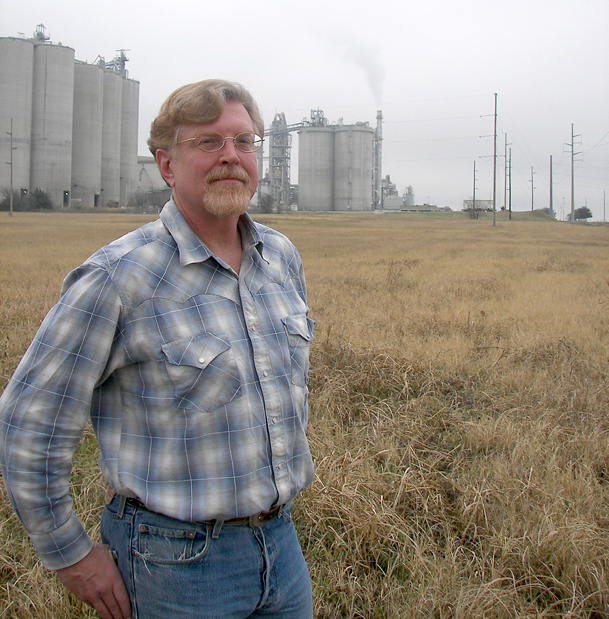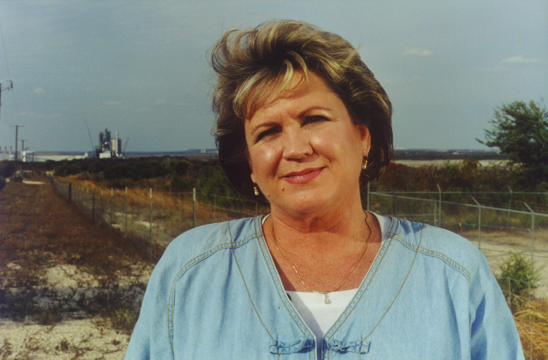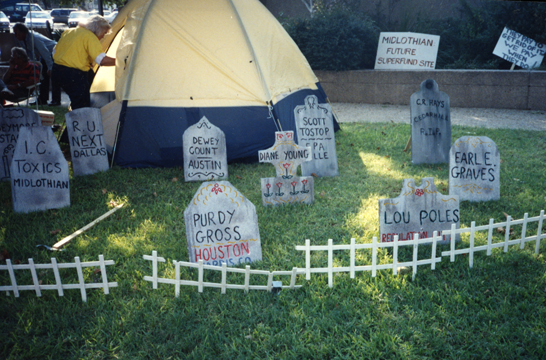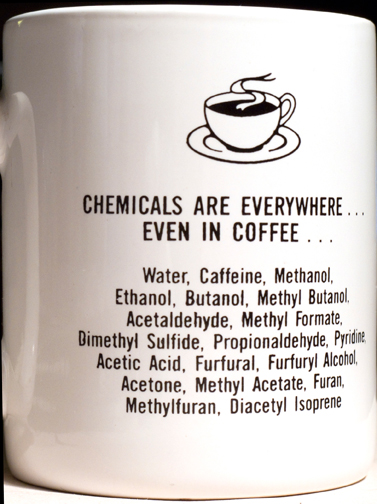You could say that bake sales brought down the four cement kilns that closed in Midlothian last month. Or that garage sales, green cement, and a mythical peanut butter and jelly sandwich are responsible for helping clean up North Texas air.
 All those things are part of the story of how a ragtag group of activists has managed to win a series of major victories against area air pollution. But longtime leaders of the group say that what has really helped the Downwinders at Risk stay the course for more than two decades, against huge odds and giant, powerful opponents, is determination and resilience.
All those things are part of the story of how a ragtag group of activists has managed to win a series of major victories against area air pollution. But longtime leaders of the group say that what has really helped the Downwinders at Risk stay the course for more than two decades, against huge odds and giant, powerful opponents, is determination and resilience.
In July, Texas Industries, the largest cement producer in Texas, announced that it will permanently close its four “wet-process” cement kilns in Midlothian — news that caused environmentalists, local citizens, and many area politicians to breathe a (much cleaner) sigh of relief. For the Downwinders, it’s a very welcome step — but by no means the end of their quest.
The group was founded in 1993, though many members of the group had been involved in fighting pollution in Midlothian for almost 10 years before that. It was formed to combat the practice of hazardous-waste burning at some area cement plants — an activity that, amazingly, was not even regulated at that time under federal and state law. The Downwinders, mostly PTA moms and a few activists, were convinced that the noxious smoke plumes billowing out of a pack of cement kilns — one of the heaviest concentrations of waste-burning industries in the country — might actually have an adverse effect on the health of people living nearby. For that, they were considered fringy.
“We were portrayed as the crazy people who were accusing the cement plants of causing deformations in cattle,” said Jim Schermbeck, one of the founding members and the first employee of the Downwinders.
They lost plenty of battles, against the cement plants, state and federal regulators, big-name politicians, and others. But they kept on, funding their fight by auctioning baked goods, working carnival booths, selling their personal effects, and often putting their personal lives on hold.
“A lot of people get involved in these fights, and if they don’t win it in six months, they think, ‘Well that was useless,’ ” Schermbeck said. “Political fights take a long time, especially for small groups of people. Trying to change the course of an aircraft carrier … takes a while.”
 Along the way, the Downwinders broadened the focus of their efforts, from one polluting industry to North Texas air quality in general. As a result, members believe, they have not only played a major role in getting the four kilns shut down and others operating much more cleanly, but they have also affected regional policy on air quality and how cement kilns are regulated. They created a fund to finance clean-air projects throughout the Metroplex. The group is responsible for multiple studies on the environment. They can take credit for launching the career of the current regional director of the Environmental Protection Agency, whose actions are now having an effect across Texas. And the EPA recently included the group in a roundtable of heavy-hitters in the world of environmental activism — the committee that is charged with gathering ideas on how to clean up air in the region.
Along the way, the Downwinders broadened the focus of their efforts, from one polluting industry to North Texas air quality in general. As a result, members believe, they have not only played a major role in getting the four kilns shut down and others operating much more cleanly, but they have also affected regional policy on air quality and how cement kilns are regulated. They created a fund to finance clean-air projects throughout the Metroplex. The group is responsible for multiple studies on the environment. They can take credit for launching the career of the current regional director of the Environmental Protection Agency, whose actions are now having an effect across Texas. And the EPA recently included the group in a roundtable of heavy-hitters in the world of environmental activism — the committee that is charged with gathering ideas on how to clean up air in the region.
But, according to Sue Pope, founder of Downwinders at Risk, their biggest accomplishment has been swaying public opinion and making public officials more aware of environmentally sound practices.
“I think that the group has really made a lot of information available to the public — what the pollution can actually do to the human body and how it affects the Metroplex and the welfare of our children,” she said.
Their work is far from over. There are still three wet kilns — much more toxic than the dry kilns that use a newer technology — operating in Midlothian under the ownership of Ash Grove Cement Company. And TXI recently informed the group that it intends to begin using its only remaining operational kiln as a waste-burning incinerator. Schermbeck said members of the TXI board have told the group that the company is considering burning tires, biofuels, and the plastic-laden innards of car seats (which create the cancer-causing substances known as dioxins), among other potentially hazardous materials.
“It’s a little disheartening — they say that they can do all this without a public hearing, so we feel like we’re back to stage one,” Schermbeck said.
TXI denies that the group’s efforts were a factor in the decision to close the plants. Company spokesman David Perkins said that, given the kilns’ age and the nation’s economic situation, the move simply made financial sense.
Relations between TXI and the Downwinders, mostly frigid through the years, have thawed a bit recently. Both sides say they are communicating more now.
Pope said that she feels vindicated for the time and energy she has spent on the struggle against the cement plants.
“I want other people who are faced with similar circumstances to stick to their guns,” she said. “When you’re right, you’re right. And you don’t just back down and let them run over you.”
A worldwide economic downturn in the early 1980s hit the energy, cement, and petrochemical companies hard. The recession also convinced many lawmakers that they needed to pump money back into the economy by relaxing industry regulation.
The result: a new federal law that allowed the burning of hazardous and toxic waste in industrial boilers and furnaces and called it “recycling.” At that time, no federal permit was required, and, astonishingly, air emissions from the burning of the waste were not regulated. It was a major financial windfall for operators of such plants, and an ill wind for the health of North Texans.
Owners of cement plants and other facilities that were never designed to burn such waste found they could make money by charging other companies a fee to get rid of their toxic byproducts. Since there was no law governing emissions at such plants, they could charge significantly less than single-purpose hazardous waste incinerators and landfills, which did have to follow emissions standards. Scores of refineries and chemical plants started saving money by shipping their waste to Midlothian, home to several kilns built in the 1960s and ’70s.
Cement plants produce that all-important component of concrete by heating a blend of ground limestone and shale to intense temperatures. The older version of that process is used in wet kilns, where the limestone-shale blend is mixed with water into a slurry. In recent decades, dry-kiln operators have found ways to heat and blend the mixture without adding water.
Overall, cement plants are the United States’ third-largest source of airborne mercury, which, when it eventually falls to the ground and enters water sources, is highly neurotoxic. And that’s not even taking into account all the other scary pollutants issuing from cement plant smokestacks.
 In 1986, Gifford-Hill Cement Company (now Ash Grove) began to use hazardous material to fuel its three wet-process cement kilns in Midlothian — the first cement plants in Texas to serve a dual purpose as hazardous-waste incinerators. A short time later, TXI jumped on the hazardous-waste-burning bandwagon with its four wet-process kilns in Midlothian. That same year, Box-Crow Cement Company opened a dry kiln there as well, making the Ellis County town the first place in the country to house three different cement plants and eight kilns.
In 1986, Gifford-Hill Cement Company (now Ash Grove) began to use hazardous material to fuel its three wet-process cement kilns in Midlothian — the first cement plants in Texas to serve a dual purpose as hazardous-waste incinerators. A short time later, TXI jumped on the hazardous-waste-burning bandwagon with its four wet-process kilns in Midlothian. That same year, Box-Crow Cement Company opened a dry kiln there as well, making the Ellis County town the first place in the country to house three different cement plants and eight kilns.
Both TXI and Gifford-Hill applied for state permits to store and blend hazardous waste on site at their Midlothian cement plants. Midlothian was becoming the hazardous-waste-burning capital of Texas. TXI’s permit request alone was for over 200 million tons of waste per year, most of it to be burned in North Texas, the largest such request in U.S. history.
Local residents couldn’t ignore the increasing clouds of smoke billowing out of the Midlothian plants, though some Ellis County politicians continued to do so. A group called CAUSE (Citizens Aware and United for a Safe Environment), a precursor to the Downwinders, organized and began meeting. The group held rallies and petition drives and even set up a tent city outside of the Austin headquarters of the Texas Water Commission (a predecessor of the Texas Commission on Environmental Quality). They made little headway, however.
By the early 1990s, it was clear that the loopholes were going to close to some extent: The first, mild federal air-emissions regulations were proposed for hazardous-waste-burning cement kilns, though that version did not pass.
However, when the kilns’ hazardous-waste business grew to the point where they had to build waste-storage facilities, that triggered provisions under an existing law. That federal statute required the plants to get permits and to give public notice. Now the Downwinders had a forum for their fight.
 Three years after the plants started their hazardous-waste onslaught, Schermbeck remembers, he attended his first public meeting in Midlothian to represent CAUSE. At the meeting, hosted by the cement plant operators, company officials explained why the “recycling” they had been doing now required a federal hazardous-waste permit. According to Schermbeck, a plant spokesman said that living downwind of a hazardous-waste-burning cement plant was no riskier than eating a peanut butter and jelly sandwich every day. It was a comparison the activist never forgot.
Three years after the plants started their hazardous-waste onslaught, Schermbeck remembers, he attended his first public meeting in Midlothian to represent CAUSE. At the meeting, hosted by the cement plant operators, company officials explained why the “recycling” they had been doing now required a federal hazardous-waste permit. According to Schermbeck, a plant spokesman said that living downwind of a hazardous-waste-burning cement plant was no riskier than eating a peanut butter and jelly sandwich every day. It was a comparison the activist never forgot.
In Austin, State Rep. Keith Oakley of Terrell proposed that the state begin to regulate the kilns as well, but his bill died without even getting a hearing. Gov. Ann Richards created a special task force on cement kiln incineration practices, which recommended that kilns be held to the same standards as single-purpose hazardous-waste incinerators. However, before the regulations could be adopted, several state agencies went through a reorganization. When it was over, the relatively environmentally friendly lead official on the issue had been replaced by another Richards appointee, this one industry-friendly. The regulations were never adopted. Disappointed environmentalists accused Richards of knuckling under to industry in the run-up to her re-election bid.
CAUSE members were getting frustrated. The group dissolved, and in 1993, Pope, Schermbeck, and others began meeting as Downwinders at Risk. They hosted a series of informal meetings at local libraries around the Metroplex, educating the public on the dangers of the hazardous-waste burning at the TXI and Gifford-Hill plants. The group’s goal was to take the fight to people who were being affected by the plants’ pollution but who weren’t tied to the plants economically.
According to Schermbeck, the group realized that Midlothian was a company town, where cement plants provided 60 percent of the tax base. As long as the fight was only about Midlothian, he told a Fort Worth Weekly reporter, citizens would never win.
In its first few months, Downwinders meetings were small, but led to bigger and more frequent presentations in front of church groups, PTAs, and other community groups across the Metroplex. Those audiences provided the group with its initial wave of volunteers and board members. Their first big action was a documentary about cement plant incineration, which Downwinders helped produce with the American Lung Association and for which they interviewed residents and doctors around Midlothian. After viewing the premiere of the film, the head of the Texas Natural Resource and Conservation Commission — the new state environmental agency — promised state regulation for the kilns but never delivered.
In 1994, two events occurred that significantly affected the burgeoning Downwinders and North Texas air quality: George W. Bush, who would prove to be a rubber stamp for polluters, defeated Ann Richards in the governor’s race, and Holnam, a Swiss-based cement multinational, purchased Box-Crow Cement. (Holnam would later change its name to Holcim and play a crucial part in the hazardous-waste debate.)
The following year, the PTA moms on the Downwinders board proposed a resolution at the national PTA convention to condemn the burning of tires and hazardous wastes in cement kilns. The resolution passed, despite the efforts of industry lobbyists, who bought a booth at the convention and hired a person in a Big Bird costume to entertain children.
Soon after that, the Downwinders, with bake sale and garage sale money, hired a toxicologist to do a comparative health study of the residents of Midlothian and a control group in Waxahachie. The study found a 30 percent increase in respiratory problems among those living close to the kilns. The Downwinders also published a report called “Sacrificing Science for Convenience” that criticized the guidelines set by the state for what were allegedly safe levels for chemical exposure. The group asserted that the Effects Screening Levels (ESL) were not based on science and depended on corporate studies and memos from manufacturers.
Four years into their fight against TXI’s permit, and with other companies still burning hazardous waste full-tilt, the Downwinders kicked up their game another notch. They began attending the meetings of a committee appointed by the North Central Texas Council of Governments, to develop a plan to clean up North Texas’ air enough to bring it into compliance with federal clean-air regulations. But even though Downwinders believed that the science showed that the Midlothian kilns were the largest industrial sources of smog-forming pollution in the North Texas area, the committee wouldn’t even take the kilns into consideration. Downwinders confronted the Bush-appointed chair of the state environmental agency with their studies but were ultimately ignored.
Over the next several years, the Downwinders added a new tactic. They began to recruit cities that are downwind of the Midlothian plants to pledge small amounts of money to help pay for attorneys and expert witnesses. The group also canvassed homes throughout the Metroplex in the hopes of convincing voters to write supportive letters to their city council members. They won support in some places, like Dallas, Fort Worth, DeSoto, and Duncanville.
 One city that didn’t sign on was Arlington, led by Mayor Richard Greene. (Ironically, a few years later Greene would become the regional administrator for the EPA.) His city hired a consultant to determine whether emissions from TXI would affect its air quality. Despite the fact that smokestacks from three TXI cement plants were visible from I-20 in South Arlington, according to Schermbeck, the consultant determined that the plants posed no threat.
One city that didn’t sign on was Arlington, led by Mayor Richard Greene. (Ironically, a few years later Greene would become the regional administrator for the EPA.) His city hired a consultant to determine whether emissions from TXI would affect its air quality. Despite the fact that smokestacks from three TXI cement plants were visible from I-20 in South Arlington, according to Schermbeck, the consultant determined that the plants posed no threat.
Greene said recently that, had he known that federal clean-air regulations would eventually be toughened, he would have taken a different stance.
The group ratcheted up its fund-raising efforts to keep Schermbeck in its employ and to pay for the permit fight. They had managed to secure some grant money but also kept on with their other fund-raisers, holding garage sales, running concessions for barbecue and cotton candy, hosting wine tastings.
TXI responded by escalating its own defensive efforts, employing tactics familiar to observers of the Barnett Shale controversy. The cement company hired a public relations firm and launched an all-out attack. The PR firm accused the Downwinders of being “hysterical housewives” and “alarmist environmentalists.” The firm took out full-page ads in local newspapers and convinced one television station to endorse TXI as a “good neighbor.” Political contributions from TXI to local, state, and national politicians skyrocketed.
In the end, the hearing for the permit, conducted by Texas Natural Resource Conservation Commission, turned out to be just a formality: TXI got everything it wanted. In a last-ditch effort, the Downwinders tried to force TXI to add equipment called scrubbers to remove from its smokestack emissions the sulfur compounds that cause many health problems. That effort also failed.
The Downwinders had spent more than four years attending hearings, organizing, and walking door-to-door in neighborhood after neighborhood, in some cases spending major amounts of time away from their families — and got nothing for it.
“It was devastating,” Schermbeck said. “That was the whole purpose of the group, to beat that permit. And we didn’t beat it, so what the hell do we do now? There was a lot of crying.”
 The loss taught him a hard lesson. “I can’t tell you how many times I’ve just been plain wrong,” he said. “And felt guilty for talking people into believing they could change things when in fact, nothing changed for a very long time. This fight has been very humbling. I don’t feel like I have the answers anymore, or at best maybe only pieces of answers.”
The loss taught him a hard lesson. “I can’t tell you how many times I’ve just been plain wrong,” he said. “And felt guilty for talking people into believing they could change things when in fact, nothing changed for a very long time. This fight has been very humbling. I don’t feel like I have the answers anymore, or at best maybe only pieces of answers.”
The group lost a lot of members after that. Two board members moved their families out of Midlothian. And a lot of the momentum that had been building with their members and the community dissipated.
But as it turned out, that crushing defeat also became a key turning point for the Downwinders. The regulatory machinery was gearing up to write the new plan for lowering smog levels in North Texas. Instead of falling apart, the Downwinders became a leader in the fight for clean air for the entire region.
The new battle changed the way the group saw itself. The TXI permit fight had galvanized those who stayed active in the group. The goal of eliminating hazardous-waste burning was still supreme, but clearly the path to that goal would have to be less direct.
Members of the group began to attend meetings of the North Texas Clean Air Steering Committee, the group charged with developing the clean-air plan. There were no environmentalists on the panel. Downwinders interrupted presentations, researched and distributed their own information, and asked the committee to back up its assertions with science.
The activists pushed for the committee to recommend state-of-the-art technology for kilns that could reduce pollution by 30 to 90 percent. Committee members argued that the area’s ozone problem was being created by cars and that cement plants weren’t a big factor. The committee’s final plan called for a voluntary 30 percent reduction in emissions from Midlothian cement kilns — which never happened.
The committee missed its deadline for submitting the plan by a whole year. When the EPA continued to drag its feet on taking any action to force the state into compliance with clean-air statutes, a coalition that included the Downwinders and three other groups sued the agency in 2002.
Two years later, the EPA settled with the coalition. The terms included a requirement that Texas commission a study of the kind of state-of-the-art kiln technology that the Downwinders had been advocating for years.
The group saw it as a major victory and a vindication of their new strategy — and there were more victories to come.
While the Downwinders were consumed with fighting the TXI permit, Holcim had been making its own plans. In 1998, the company had announced plans to build a new cement kiln in Midlothian and refurbish its existing unit. Company officials predicted that the changes and new unit would produce 50 percent more cement, while cutting emissions by 50 percent. Pope was skeptical and fought the permit, but was denied a hearing. Three years later, when the new kiln and refurbished unit came online, the performance was nowhere near what had been promised: The plants exceeded the company’s permit for allowable smog-forming emissions by 50 percent.
Holcim responded by asking to negotiate a settlement with Downwinders to avoid a lawsuit. The group refused at first; then the EPA offered to mediate, and the Downwinders agreed to hear Holcim out.
TXI, its hazardous-waste permit in hand, was also planning a new dry kiln in Midlothian. But this time, the company was forced by new federal emissions standards to implement pollution-control technologies. At one point, TXI tried to get permission to turn off one of the most effective pollution-control devices — a second flame that burns a good portion of the pollution — to save money. The Downwinders fought the attempt in 2003, and won another battle. They were officially on a roll.
One of the Downwinders’ biggest triumphs came in 2004, when the group successfully campaigned to bring Ellis County into the “non-attainment area” for the next round of air-quality planning. Translation: Despite the best efforts of Gov. Rick Perry and U.S. Rep. Joe Barton, the EPA insisted that pollution from the Midlothian plants be factored into the Metroplex’s clean-air plans.
One of the key players in the fight to get Ellis County included was Greene, the former Arlington mayor.
This time around, representatives from environmental groups were included on the clean-air planning committee. The Downwinders were officially represented by its sister group, the Blue Skies Alliance, but Schermbeck ended up occupying the slot by the end of the process.
 The Holcim settlement with Downwinders was also announced that year. Holcim agreed to place an air monitor near Pope’s house, pay a scientist/engineer to monitor the plant’s operations and test burns for citizens, and provide the Downwinders with $2.3 million for grants to fund clean-air projects in the Dallas-Fort Worth area.
The Holcim settlement with Downwinders was also announced that year. Holcim agreed to place an air monitor near Pope’s house, pay a scientist/engineer to monitor the plant’s operations and test burns for citizens, and provide the Downwinders with $2.3 million for grants to fund clean-air projects in the Dallas-Fort Worth area.
The Downwinders named the fund after Pope, their founder and the person who was the most skeptical of Holcim’s earlier plans. It’s the largest private fund for clean air ever created in Texas and the only one run by citizens themselves. And the person they hired to monitor the plant’s operation: Al Armendariz, who went on to replace Greene as EPA regional administrator.
The first Sue Pope Fund grant went to a Dallas County pilot program for catching counterfeit inspection stickers and cars that spew dirty exhaust. Other grants have gone to Habitat for Humanity to increase the energy-efficiency of the homes it builds, to a South Dallas neighborhood so residents could install solar panels on their homes, and for air-conditioning the McKinney Avenue Trolley system. Other Pope grants have gone for subsidies of the only mass transit Arlington has ever had, for “green” service vehicles for the Fort Worth school district, and, in Midlothian, the first gas-electric hybrid school bus in North Texas.
As part of the settlement, Holcim also agreed to test a new, cleaner technology called selective non-catalytic reduction (or SNCR, pronounced “snicker”). The company agreed that if the test was successful, it would install the technology permanently. Up to that point, both the Texas cement industry and TCEQ were on record as maintaining that SNCR would never work in Midlothian because of the “uniqueness of the rock chemistry.” Holcim’s test proved it did work, and Holcim became the first cement plant in the U.S. to do a full-scale SNCR retrofit.
The Downwinders believe that another of their initiatives, begun in 2006, has played a major part in tipping the balance in the cement kiln debate. That’s their “green cement campaign,” through which they convinced a long list of counties, cities, and school districts in North Texas to adopt environmentally conscious policies regarding the cement used in their projects.
The basis of the campaign was simple: The group lobbied cities, businesses, and other organizations that buy cement to agree, whenever possible, to buy from companies that use cleaner practices. Schermbeck and others believe it was that campaign that ultimately wore down TXI and will someday wear down Ash Grove.
“It was a great free-market response to a regional air-quality problem,” said Schermbeck. “I think that strategy paid off and was one of the nails in the coffin for those wet kilns.”
In October 2008, TXI announced that it would temporarily idle its four wet-process cement kilns. The company blamed the recession, though the kilns aren’t expected to ever operate again.
“We looked at our long-term plans for the plant and recognized that though the economy isn’t where it needs to be, it’s ultimately going to get back, and there’s going to be a need for infrastructure for homes and schools, buildings and roads,” said Perkins, the TXI spokesman. “And in order to best meet those demands, it makes more sense to do it with the most efficient [plant] — from an energy and an emissions standpoint — and that means not continuing to operate those wet kilns.”
A month later, Ash Grove sued all of the local governments that had passed green cement policies, claiming illegal discrimination. Thus far, the suit’s result has mostly been to stop more cities and counties from adopting such policies. However, Denton, the University of North Texas and the Fort Worth school district wrote new green cement policies over the following year.
The Ash Grove suit is still pending in state court. Many observers believe it will be dismissed.
Another contributing factor in TXI’s decision could be that its board has been in some turmoil. The company’s third-largest shareholder, Shamrock Activist Value Fund — backed by Walt Disney’s nephew, Roy Disney — is trying to replace three members of TXI’s board with its own candidates. And they are gaining momentum. (“Activist,” in this instance, refers to shareholder activism, not environmental concerns.)
The Downwinders have had limited contact with the insurgent shareholders.Many observers believe that the current board members and officers may be more willing to close the dirtier kilns in order to stave off negative publicity and make their own positions more secure — a way to sweep years of bad press under the rug.
Now, Schermbeck said, Ash Grove has taken over TXI’s role, in using bogus science to justify using dangerous, antiquated equipment.
“It’s funny — Ash Grove has kind of become the poster boy for backward-looking, illogical business decisions and bone-headed PR moves,” he said. “I don’t understand their thinking. I don’t understand why they are clinging to this plant.”
Ash Grove officials did not respond to the Weekly’s request for comment on this story.
TXI’s decision to close the kilns may also have been influenced by the fact that the cement companies’ united front has fallen apart.
The Downwinders are still focused on trying to get cement companies to use the best available technology to reduce emissions. “The last five years have been about trying to bring state-of-the-art pollution-control equipment to them, to get rid of the worst actors — the wet kilns,” said Schermbeck.
Many pounds of baked goods and miles of pounded pavement later, the Downwinders have built a sizable record of bringing about change in both the natural and political environment in North Texas and beyond — pollution controls put in place, kilns closed, policies changed, and clean-air plans strengthened. Add it all up, and Schermbeck figures the group is responsible for stopping tens of thousands of tons of pollution from entering the North Texas atmosphere. (The shut-down TXI kilns alone produced 12,600 tons of waste in their busiest year.)
Many of the kilns in Midlothian have added new technologies that have reduced their emissions — and that has had an effect outside of Texas. Ironically, the Midlothian kilns are becoming an example for other companies on how to retrofit kilns to make them more environmentally friendly.
Earlier this month, the EPA announced new regulations on cement kilns. The federal agency set the nation’s first limits on mercury emissions from existing kilns and strengthened limits for new kilns.
TCEQ recently conducted its own study of air quality in Midlothian. Researchers sampled the air for an entire year — though it just happened to be the year TXI suspended operations at the four kilns the company would eventually close. The state agency reported that the air quality in Midlothian was acceptable.
Pope said that she is pleased with the report’s unintended consequences.
“You feel like in some ways that was a waste of money, but the way I look at it is now we have a benchmark — what the air quality should be in Midlothian,” she said. “So we have something to refer to now.”
John Rath, a leader of the Dallas chapter of the Sierra Club, said that the Downwinders have become a model of grassroots organization and now have a national reputation.
“They have a cause, they’re passionate about it, and they brought people together over it,” he said. “Many of them have stuck with it since 1989. They have stuck together and definitely made an impact on the quality of our air. And yes, they have gotten some well-deserved name recognition over the last couple of years.”
Even TXI is talking to them more these days. Perkins said the company is committed to continuing that conversation.
“We live in this community as well, and we believe it’s important to improve air quality,” he said. “We also want to work with all of the stakeholders, including Downwinders at Risk, in the future to achieve those goals.”
Schermbeck said that the group isn’t going away — especially when he and others can see the difference they’re making.
“Midlothian is still a hot-spot of pollution, but it’s not nearly as bad as it used to be,” he said, “and I think [that wouldn’t have happened] if not for this group constantly pressuring industry and government to make it better.”











